National personification

A national personification is an anthropomorphism of a nation or its people. It may appear in editorial cartoons and propaganda.
Some early personifications in the Western world tended to be national manifestations of the majestic wisdom and war goddess Minerva/Athena, and often took the Latin name of the ancient Roman province. Examples of this type include Britannia, Germania, Hibernia, Helvetia and Polonia. Examples of personifications of the Goddess of Liberty include Marianne, the Statue of Liberty (Liberty Enlightening the World), and many examples of United States coinage. Examples of representations of the everyman or citizenry—rather than of the nation itself—are Deutscher Michel and John Bull.[1]
Personifications by country or territory
| Country | Image | Personification |
|---|---|---|
| |
|
Mother Albania (Nëna Shqipëria) |
| |
 |
Effigy of the Republic/Liberty/Progress/Fatherland, Gaucho, Martín Fierro |
| |
 |
Mother Armenia (Mayr Hayastan; lit. "Mother Hayastan") |
| |
 |
Little Boy from Manly |
 |
Austria | |
| |
Bangamata (lit. Mother Bengal); Bengal tiger.[2]
Joy Bangla (Bengali: জয় বাংলা; meaning "Victory to Bengal") was the slogan and war cry of the Mukti Bahini that fought for the independence of Bangladesh during the Bangladesh Liberation War in 1971.[3] | |
| |
 |
La Belgique or Belgica. The country is also commonly represented by a lion, historically known as Leo Belgicus. |
| |
 |
Efígie da República; the Bandeirante (only in São Paulo State); the Candango (in Brasília); the Gaúcho (in Rio Grande do Sul) |
| |
 |
Mother Bulgaria |
| |
Preah Thong and Neang Neak | |
| |
 |
Mountie, Johnny Canuck, Le Vieux de '37 (French Canada), Adam Dollard des Ormeaux (used during the two World Wars as a military example), Mother Canada (at the Canadian National Vimy Memorial) |
| |
 |
El Roto, El Huaso, La Carmela, Doña Juanita (an average Chilean woman from the countryside), Moya (a common surname used as N.N.) |
| |
 |
Čechie, Czech Vašek, double-tailed Czech lion, Svejk. |
| |
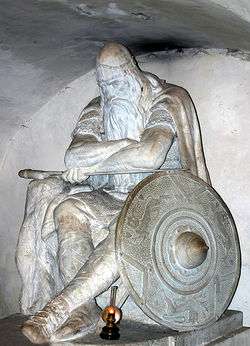 |
Holger Danske |
| |
 |
Conchoprimo |
| |
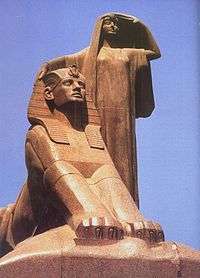 |
Mother of the World (Om El Donia) |
| |
 |
Monumento al Divino Salvador del Mundo |
| |
.jpg) |
Europa or Europa regina |
| |
 |
Finnish Maiden (Suomi-neito) |
| |
 |
Marianne |
| |
 |
Georgia: Saint George, "Mother of a Georgian" (Kartvlis Deda) |
| |
.jpg) |
Germany: Germania, Arminius (Hermann der Cherusker), Deutscher Michel
Bavaria: Bavaria, Berlin: Berolina, Brunswick: Brunonia, Franconia: Franconia, Hamburg: Hammonia, Prussia: Borussia, Palatinate: Palatia, Saxony: Saxonia |
| |
 |
Athena, Hellas (es) |
| |
 |
Ezili Dantor |
| |
 |
The Lady of Hungaria |
| |
 |
The Lady of the Mountains (Fjallkonan) |
| |
 |
Bharat Mata ("Mother India"), earlier the goddess Durga. Also the tiger or the Indian elephant is used to personify the nation. But strictly speaking of national personification, the figure of Bharat Mata as a goddess, wearing a white or saffron sari, holding the national flag, and having a lion as her vahana is the most widely popular personification. The battle cry, "Bharat Mata ki Jai" (Victory for Mother India) is used by the Indian Army and is one of the most popular patriotic slogans used in India. |
| |
|
Ibu Pertiwi |
| |
 |
Cyrus the Great |
| |
 |
Ériu, Banba, Fódla, Kathleen Ni Houlihan, Hibernia, Scotia,[4] Granuaile, The Old Woman of Beare[5] |
| |
 |
Srulik |
| |
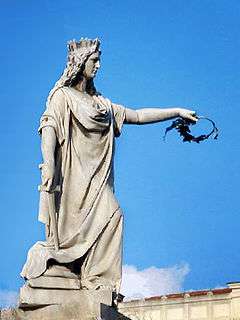 |
Italia Turrita |
| |
Abu Mahjoob | |
| |
Dangun, Ungnyeo, Korean Tiger, Yangban | |
| |
Mother Macedonia[6][7] | |
| |
 |
Hang Tuah, Harimau Malaya |
| |
 |
Melita |
| |
 |
Alegoría de la Patria Mexicana (es), Our Lady of Guadalupe, La China Poblana |
| |
 |
Barbary Lion |
| |
 |
Dutch Maiden, Dutch Republic Lion |
| |
|
Kiwi, Zealandia, southern man (for the South Island) |
| |
 |
Mother Norway, stereotyp. Ola Nordmann & Kari Nordmann, hist. Nór |
| |
 |
Handala |
| |
The chalán, La Madre Patria | |
| |
Juan dela Cruz, Ináng Bayan, Filipinas, Philippine eagle | |
| |
 |
Polonia |
| |
 |
Zé Povinho, Eu nacional (National Self), Republic effigy, Guardian Angel of Portugal |
| |
 |
România |
| |
 |
Mother Russia/Mother Motherland |
| |
 |
Mother Serbia, Kosovo Maiden |
| |
|
Merlion |
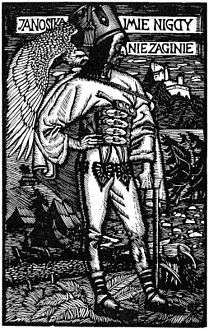 |
Jánošík | |
| |
Kranjski Janez ("John from Carniola", an average man from Slovenia's central region), Peter Klepec | |
| |
_03b.jpg) |
Hispania |
| |
|
Mama Sranan (Mother Suriname), a 1965 sculpture by Jozeph Klas in the center of Paramaribo, of a mother figure holding five children representing Suriname's ethnic groups in her arms.[8] |
| |
|
Mother Svea |
| |
.jpg) |
Helvetia |
| |
 |
Phra Siam Devadhiraj (พระสยามเทวาธิราช "The guardian angel of Siam"), Thailandia, Khun Borom |
| |
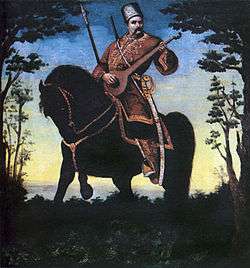 |
Cossack Mamay |
| |
 |
Britannia, John Bull |
| |
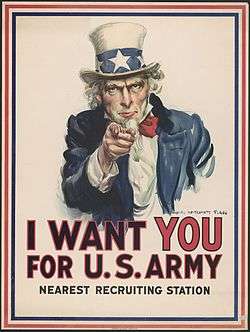 |
Uncle Sam (government personification), Statue of Liberty as Lady Liberty, Columbia, Johnny Rebel (The South, obsolete), Billy Yank (The North, obsolete), Brother Jonathan |
See also
- Countryballs, a contemporary form of national personification in which countries are drawn by Internet users as stereotypic balls and shared as comics on online communities.
- Hetalia, an anime and a manga series, that features personifications of countries.
- Mural crown
- National animal, often personifies a nation in cartoons.
- National emblem, for other metaphors for nations.
References
- ↑ Eric Hobsbawm, "Mass-Producing Traditions: Europe, 1870-1914," in Eric Hobsbawm and Terence Ranger, eds., The Invention of Tradition (Cambridge, 1983), 263-307.
- ↑ "NATIONAL SYMBOLS". Bangladesh Tourism Board. Bangladesh: Ministry of Civil Aviation & Tourism.
- ↑ Ahmed, Salahuddin (2004). Bangladesh: Past and Present. APH Publishing. p. 310. ISBN 8176484695. Retrieved July 11, 2012.
- ↑ O'Clery, M. (2003) Annals of Ireland by the Four Masters as translated into English
- ↑ O'Rourke Murphy, M. & MacKillop, J. (2006). An Irish Literature Reader: Poetry, Prose, Drama.
- ↑ "A Manifesto from the Provisional Government of Macedonia". 1881.
Our mother Macedonia became now as a widow, lonely and deserted by her sons. She does not fly the banner of the victorious Macedonian army
- ↑ Bulgarian graphic representation of Bulgaria, East Rumelia and Macedonia
- ↑ http://www.parbode.com/opinie/item/2629-kunstschatten-mama-sranan
Further reading
- Lionel Gossman. "Making of a Romantic Icon: The Religious Context of Friedrich Overbeck's 'Italia und Germania.'" American Philosophical Society, 2007. ISBN 0-87169-975-3.
External links
| Wikimedia Commons has media related to Personifications of nations. |
- A scholarly case study of the evolution of Deutscher Michel
- Kirsten Stirling: "The Image of the Nation as a Woman in Twentieth Century Scottish Literature"
